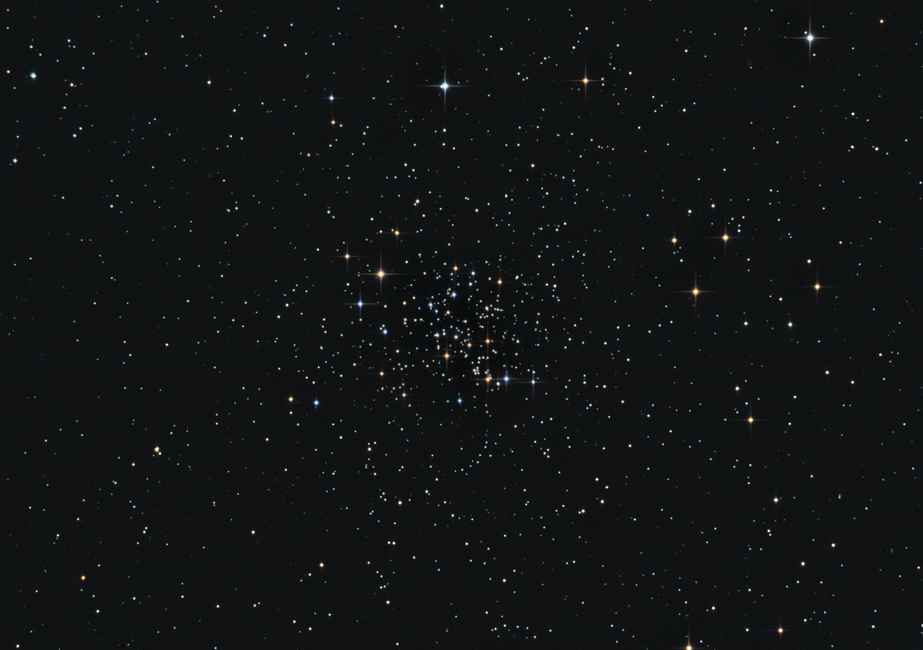M67 (NGC 2682)
Characteristics:
Magnitude: 6.9
Size: About 29'
Distance: 2700 light years
RA: 08h 50m 50.1s
Dec: 11 degrees 48' 44"
Description:
M67 is an open star cluster, also
known as a galactic cluster. Before describing the unique
features of M67, it is worth briefly describing the more typical
characteristics of open clusters. Such clusters are loose stellar
associations usually located within our galactic plane. They are
relatively young, in the age range of less than 200 million years, and
contain stars that are generally metal rich, having formed from the
remnants of previous supernovae explosions. Examples of
typical open clusters include the Pleiades, the
Hyades, Ursa Major
(yes, the entire constellation!), and the Beehive cluster.
The
stars comprising open clusters generally disaggregate over time, being
pulled apart by the influence of other stellar encounters as they orbit
within the galactic plane. This is why most open clusters are
relatively young (they don't exist long enough to become old) and have
stars that are still on the main
sequence. In a typical open
cluster we would expect to see a few scattered red giants, but most
of
the stars will be blue to orange main sequence stars still burning
hydrogen to helium in their cores. Once the stars disaggregate
and go off on their own, they will eventually grow old and die, just
like stars everywhere else in the universe. Feel free to explore
my previous image
of M13 for more details about the HR diagram and stellar evolution.
The features of open clusters can be compared to those of globular
clusters, which are billions of years old and contain stars that formed
during the early epoch of the universe (i.e.,
at a time when supernovae explosions were relatively infrequent),
prior to the availability of derivative elements. This is why
most stars contained within globular clusters are metal poor.
Given the advanced age of globular clusters, most of its member stars
have evolved off the main sequence and are in the red giant or perhaps
the horizontal
branch phase of the HR diagram (in which case they would
appear blue and would be burning helium to carbon in their
cores). Unlike open clusters, globular clusters tend to be
located in orbits around the galactic center.
So based upon this information, we would expect the open cluster M67 to
be relatively young, located within in the galactic plane, and full of
stars located mostly on the main sequence. And yet, every one of
these assumptions turns out to be incorrect! M67 is one of the
oldest known open clusters, with an age of around 4
billion years
(compare this to the age of the Pleiades- 65 million years, or the
Beehive Cluster- 700 million years). Instead of being located
within the galactic plane, it is located about 1400 light years above
the galactic plane (or below it, depending upon your point of
view). This fact alone may be responsible for the advanced age of
this open cluster, since its stars have been able to avoid other
stellar encounters that would result in disaggregation of the
cluster. Because of the advanced age of this open cluster, it
follows that most of its stars have had a good life and have already
evolved off of the main sequence (which is very different compared to
most open clusters). Please click here
for an HR diagram showing
the turn off point of stars contained within M67, adapted from the
following
source
available in pdf format.
There are a few other interesting things to note about M67. It
has lots of red giants as shown in my image above. This is not
surprising given the advanced age of this cluster. However, it
has an unmistakable component of blue stars, but these do not represent
the young, hot main sequence stars that would be observed in a typical
open cluster. Instead, many of these stars are Blue Stragglers,
which are old stars that have curiously not yet left the main sequence
(even though they should have, since the HR diagram shows a prominent
turn off point). It is possible that Blue Stragglers exist
because they have received an extra "dose" of hydrogen fuel from
collision
with another member of the cluster, or from a binary partner, which
then stimulates another round of hydrogen to helium fusion (thereby
keeping it on the main sequence for a while longer). In fact,
there are several "contact binaries" present in M67 (also known as W
Ursae Majoris eclipsing binaries), which are binary systems
rotating so
closely that their surfaces actually touch. Whether Blue
Stragglers are a consequence of interaction between W Uma binaries
within M67 is unknown.
The image above represents a wide field view of M67, showing a
relatively sparse surrounding star field which is due to its position
well above (or below) the galactic plane. More information about
M67 may be
found here.
Photographic Details:
Date: April 2, 2006
Scope: Takahashi
FS102 at f6, on the G11 Losmandy
Mount.
Autoguider: SBIG STV with
e-finder.
Camera: Maxcam CM10.
Filter: Astronomik
RGB type II filter set; IDAS LPS filter.
Exposures: LRGB composite.
8 x 4' for luminance (unbinned); 4 x 3' each for R, G, and B
(unbinned). Two thin pieces of kite string attached to the dew
shield with
tape were used to create the diffraction spikes. However, the use
of thicker material (such as an elastic band)
produces more
pleasing diffraction spikes in my experience.
Conditions: Temperature 50 degrees F; poor
transparency; average seeing; calm. Conditions deteriorated quickly as clouds
moved in.
Post-processing: Subs were debloomed with Ron
Wodaski's Debloomer software, calibrated and aligned in Maxim.
Sigma combined using RC Sigma Reject
MaximDL, followed by DDP
in ImagesPlus (IP). Final processing in Photoshop CS (16
bit format).
Please
note: Graphics on this website
may not be reproduced without author permission.
Back to Star
Clusters
Home
